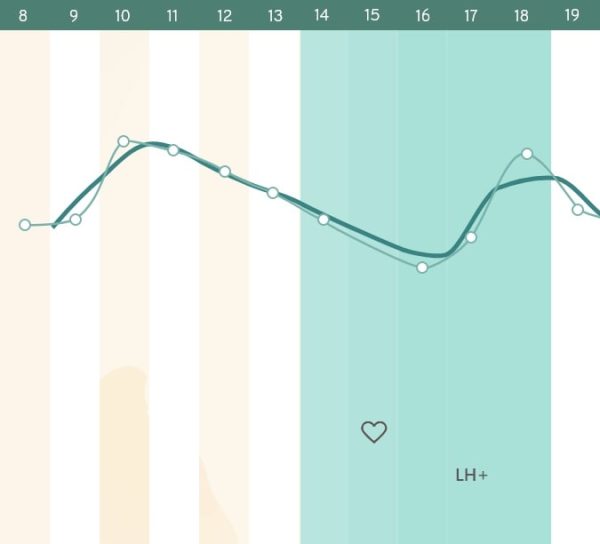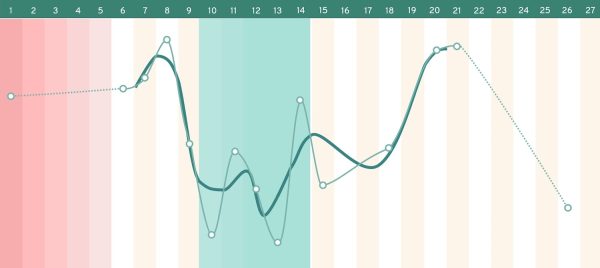Did you know?
- You can have a positive LH test, but not successfully ovulate!
- Problems with ovulation are the leading cause of infertility.
- The egg can be fertilized but may not implant due to low progesterone.
- Low progesterone can be indicative of such an ovulatory problem.
- With proper care, you can often fix an ovulatory disorder in one cycle. Talk to your doctor.
kegg & Proov are a dynamic combination
kegg is able to detect the fertile window and the hormonal switch from estrogen to progesterone dominance that follows ovulation. This is done with impedance technology.
(Learn more about how kegg works here)
Proov is an at-home urine dip test that tests a urine metabolite of progesterone called PdG. A positive Proov tests occurs when PdG levels are 5 ug/ml or greater. A recent study demonstrated that PdG of greater than 5 ug/ml on days 7-10 post-ovulation is typical in most fertile women.
Case Studies
To better illustrate how kegg works with Proov, let’s look at some case studies.
Case Study # 1: AG used Proov with her very first kegg cycle.
With kegg, AG was able to pinpoint her fertile window. She was confident that she had timed intercourse appropriately, thanks to kegg’s identification of the ovulation window. She had an ultrasound 1-day post ovulation which indeed confirmed that she had ovulated.
Next, she used Proov on days 7-10 after her peak fertility reading from kegg to determine if she had successfully ovulated. Successful ovulation occurs when an egg is released AND progesterone or PdG (progesterone metabolite) levels are elevated high enough and for long enough to provide the best chance of conception. When she used Proov on days 7-10 after her peak fertility reading from kegg, her only positive was on day 8. Sadly, she did conceive this cycle but did not start supplemental progesterone until 10 days post ovulation. She suffered an early miscarriage. She shared “While I was devastated, I also felt like I was empowered to talk to my doctor. I feel strongly my low progesterone [after ovulation] caused my miscarriage and I was determined to not attempt to conceive until I knew I could supplement with progesterone early on, even before a positive pregnancy test. Thankfully my OB was very receptive to starting progesterone and very curious to learn about kegg and Proov. She had originally told me that since I ovulated, my progesterone was adequate. Sadly this is not true for everyone and a common cause of infertility amongst women. The very next cycle, I started progesterone suppositories 3 days post ovulation. We were over the moon to learn we were pregnant this very next cycle. We are expecting a little boy in March 2021!”

Case Study #2: LZ, User with irregular cycles, pregnant on the second cycle with kegg
L. was able to identify her fertile window with kegg and then was able to confirm successful ovulation shortly thereafter. Proov and kegg also helped her identify an anovulatory cycle.
“I have PCOS with irregular cycles ranging from 40-125 days as well as hypothyroidism and conceived on my second month of using kegg. It was also my first round of Letrozole for ovulation induction. I was also using cheapie OPKs, Mira, Pearl, Clearblue Advanced, temping with wearables Tempdrop and Ovusense, tracking with the Read Your Body app, and confirming ovulation with Proov PdG strips. I was also getting weekly acupuncture sessions and took Ovasitol, CoQ10, Magnesium, and Vitamin D supplements. I had been seeing a fertility clinic for three months and overall TTC for 12 months, with only three, confirmed ovulations in that time and no positive pregnancy tests.
My first cycle with kegg was anovulatory, [and] despite showing fertile signs and positive OPKs, I never had a temperature rise or positive Proov test. I took Prometrium for 10 days to induce a period. For the next cycle (which I conceived in), I took Letrozole 5mg on cycle days 3-7. I did not receive any fertile window predictions from kegg at the time, but you can see from the pattern when I ovulated (CD15-16), which matches up to my positive OPKs, temperature rise, and dating ultrasound. I had a positive Proov test at 3 DPO and a serum progesterone test at 89.2 nmol/L on CD22 confirming ovulation. I got a positive pregnancy test at 8 DPO.
I found out from the ultrasound at 7 weeks 1 day that I am expecting twins! It wasn’t a complete surprise as I had felt ovulation twinges from both ovaries, and can see two possible implantation dips in my temperature chart. My beta HCG serum levels were also very high (5,474 mIU/mL at 20 DPO and 86,762 mIU/mL at 30 DPO).
*Note: kegg makes its predictions based on the trend of readings even with irregular cycles. One of the unique and beautiful aspects of kegg is users can discern their kegg trends regardless of the predictions, as they can view the real-time data daily. kegg users can become keen observers of their data even when cycles vary greatly from month to month. Interested in having your chart reviewed? Send us an email at hello@kegg.tech

Case Study #3: SW, user with endometriosis, pregnant after 3 cycles
Proov and kegg user SW sadly endured a miscarriage before her kegg and Proov arrived. We are thrilled to share that she was able to conceive again and is expecting a baby in June, 2021. SW was able to identify her fertile window with kegg and confirm ovulation with Proov. She writes: “When I first got my kegg, I was uncertain I was ready to try again. Initially we decided that we should use it for a few cycles so the algorithm would be set for when we were truly ready. My husband’s schedule was changed time and time again until finally we started to see that if we could conceive before the winter holidays, he would be home for the whole pregnancy! This was a huge deal for us, but because my cervical mucus was so unreliable, it was extremely hard to pinpoint ovulation. Enter kegg: after three months of using it, we were able to easily learn the days it was most likely for me to get pregnant! It was so exciting to be able to see the drop and rise in my chart and then how perfectly it lined up with my basal temperatures! It’s still early, but we’re confident that this pregnancy will be different from the last and we are so excited to welcome our rainbow kegglet June 2021.”

So how does Proov work with kegg?
With great ease, actually! Use your kegg daily (for only two minutes) to monitor your cycle. With kegg, you will know in advance when your full fertile window will likely occur. If you are trying to conceive, this information is very important for planning intimacy. Once you ovulate, you can choose if you want to confirm ovulation with a Proov test 3 days post ovulation, and/or confirm if you successfully ovulated – meaning that ovulation occurred AND PdG levels are elevated high enough and for long enough to provide the best chance at conceiving, by testing days 7-10 past peak fertility. This 7-10 day window is typically when implantation occurs, so you want to ensure your PdG is high on each of these days – indicating successful ovulation. As you read in one of our case studies above, the user AG had only one positive Proov result and three negatives for the other days within the 7-10 day window after ovulation. While you can also use an LH test to confirm your peak, many kegg users are able to simply look at their charts to know when they likely ovulated and thus when they should test with Proov.
How do I know if my progesterone is low?
While there is no sure way to know if your progesterone is adequate without testing, some women experience symptoms of low progesterone including breast tenderness, spotting between periods, depression and mood swings, PMS, low libido, headaches, and fatigue. Low progesterone is often associated with ovulatory problems, as progesterone is the hormone released after ovulation. To help discover if successful ovulation is happening, Proov has made convenient and simple at-home testing finally available. Using Proov does not require a doctor’s prescription. Proov tests a urine metabolite of progesterone called PdG. A positive Proov tests occurs when PdG levels are 5 ug/ml or greater. A recent study demonstrated that PdG of greater than 5 ug/ml on days 7-10 post-ovulation is typical in most fertile women.
How do I fix my progesterone?
Please speak to your doctor regarding your concerns. There are various ways you can go about raising your progesterone in the luteal phase. Women commonly speak to their doctor about their results and often are prescribed bio-identical progesterone. Other methods include herbal supports, diet changes, correcting thyroid imbalances, and seed cycling. For more information, check out this blog post here.
We would love to hear your story. How have kegg and Proov helped shape your fertility journey? Email us at hello@kegg.tech
